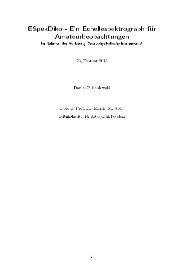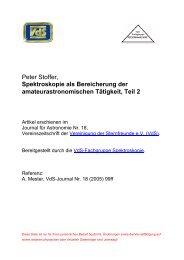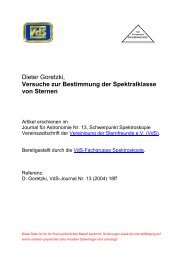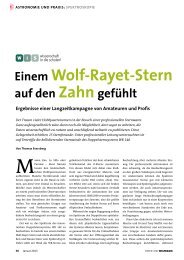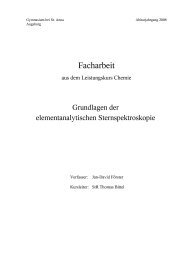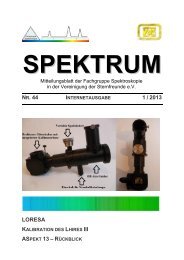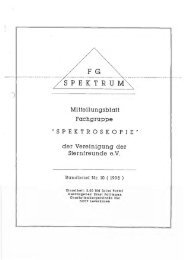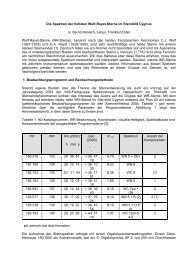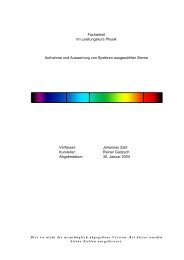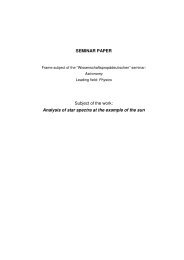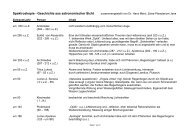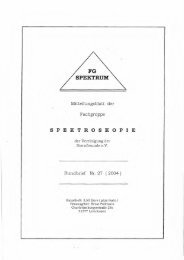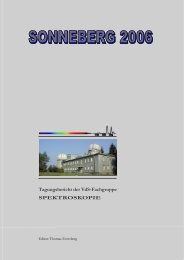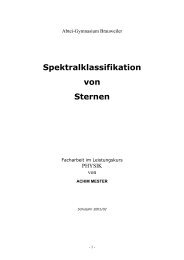An Echelle Spectrometer-Spectrograph for Astronomical Use - FG ...
An Echelle Spectrometer-Spectrograph for Astronomical Use - FG ...
An Echelle Spectrometer-Spectrograph for Astronomical Use - FG ...
Create successful ePaper yourself
Turn your PDF publications into a flip-book with our unique Google optimized e-Paper software.
I-<br />
3 I<br />
'5790<br />
in two~~ orders.Teitniisaesae ota order 70i<br />
isatk514inorrm+I d154i re m 577 +<br />
blaze. These scans were repeated <strong>for</strong> several different<br />
wavelength settings of the small monochromator. The<br />
results of these scans show that the instrumental function<br />
of the echelle can be accurately determined and is<br />
in good agreement with the expected single-slit diffraction<br />
pattern. Figure 5 shows the envelope of these<br />
scans compared with a theoretical single-slit diffraction<br />
curve and the effect of this envelope on the measured<br />
intensities of several lines. The separation of the minima<br />
in the theoretical curve is two free spectral ranges.<br />
Application of the measured blaze function to the intensities<br />
of the Hg line pairs shows that X5790 is slightly<br />
stronger than X5770. In practice all scans are restricted<br />
to the region of width 5X centered about the peak. This<br />
function need only be determined in one spectral<br />
region as the shape is independent of wavelength;<br />
only the angular width depends on wavelength.<br />
Discussion<br />
The echelle instrument proposed above shows great<br />
potential <strong>for</strong> astronomy. As pointed out by Code and<br />
Liller 5 one of the primary considerations of an astronomical<br />
spectrometer is the bandpass, or spectral<br />
purity, at the exit slit <strong>for</strong> a given entrance slit width.<br />
Calculations show that the spectral purity AXmin is<br />
given by<br />
Figh5 Fullg crvpoe Enelope the esure chewll blaze<br />
function. Dase mncromTatcige sin-si diraction cure.-<br />
Thes pot andnteniso the width9 line H s are showuio. nh<br />
AXmi. = A/[fc. iG/AX)l, 0<br />
(12)<br />
instwo orders. Thecitroensteare scale sti X5 tat thire<br />
where As is the entrance slit width, f-0l is the collimator<br />
mo atchels the mesudiurv. Thescentro thaes lze unctiond<br />
focal length, and AG/AX is the angular dispersion. It is<br />
clear from Eq. (12) that the bandpass can be decreased<br />
mirrrif the twos irrsthven thee focal engflths.-<br />
spcrmtrwl spcrlrneteisrmna edtrmndol<br />
ucino yteehle h cel only by increasing either f-ol or the angular dispersion.<br />
thue Al design fteohrotclcmoet proposed beow the rsiduals ftessefo oma will stnd There is an obvious limit to increasing fcol since the<br />
tospradamocrmatic image.Tse in ai diton pesr-ac beam diameter at the echelle is f_/telescope f ratio.<br />
ppendicular to the ecera dirsion. Thisrhowver The real gain in reducing the bandpass is there<strong>for</strong>e<br />
effected by increasing the angular dispersion, a result<br />
destnot actrdo th ie witand rfteolution hew<br />
usua dependentoverd<br />
gtiong sectoeterazo A.de<br />
obtained by using an echelle.<br />
the etrsli insenatte<br />
A spectrometer patterned after the laboratory instru-<br />
tagntialtigdeematin imgeof setgati insit pret ment is now being built <strong>for</strong> use at the Cassegrain focus<br />
sfae. Severa Ful Inqutis cans:Enl nstrumente of the thesfocalnplanetis ouptwrete echelle maue flaelade<br />
causetitnisalocatedeatnthehpositionssofythensagittae<br />
astgmti imtaes.i Thes magesli oon alato sfacea<br />
thrug abt three echn orders55 enere on the<br />
erpven icular rleua amerasmirrorlnormal<br />
to the<br />
fature cetee (aot pea of t blzfnton The sow<br />
thestrng effect of theaeont recordedla innsities.n<br />
quaiaten dthemiation ohefre spectral net Thre<br />
<strong>for</strong>ectrequresian accuratedmeasureentaofethist blaze<br />
fuction, apetrmeuement wich sueasilyt doeri thes<br />
folloingr way. Ae tungterne amp is imae uni<strong>for</strong>ly<br />
Ao the entane sliticlcmoet ah smallm of moocromaoseatn<br />
eqivalsueto wdteatry eqalt thsetal freeet rane<br />
Svrsasof the echelle (aoutpu 60r A tX8.then mno-<br />
of the University of Wisconsin 91-cm, f/13.6 telescope<br />
at Pine Bluff. The instrument will be as shown in Fig.<br />
2 except that mirror Ml will have a focal length of 1.0 m<br />
instead of 0.5 m as in the laboratory design. Two flat<br />
mirrors will fold the entrance beam and allow the telescope<br />
axis to be perpendicular to the plane of Fig. 2.<br />
This will provide a beam diameter of 74 mm at the<br />
echelle. The camera mirror M2 will have a focal<br />
length of 0.5 m. At X5000 the dispersion is 2.50 A/mm<br />
and, because of the magnification ratio, the bandpass is<br />
1.25 A/mm of entrance slit.<br />
<strong>An</strong> echelle with 30 lines/mm, when used in series with<br />
a 600 lines/mm grating, will provide a capability of<br />
photographing 1000 A of spectrum on a single 35-mm<br />
frame with the spectral purity given above. This<br />
capability is particularly attractive when considered<br />
in conjunction with an electronic imaging device at the<br />
truhattreechelle spcrmtrrIsasd cetatd oe ths<br />
focal plane. This combination of dispersing elements,<br />
will also be used <strong>for</strong> scanning of stellar sources over<br />
small spectral regions. Because of the peculiar twodimensional<br />
nature of the focused spectrum, it will be<br />
necessary to scan both the grating and echelle to keep<br />
November 1967 / Vol. 6, No. 11 / APPLIED OPTICS 1979



